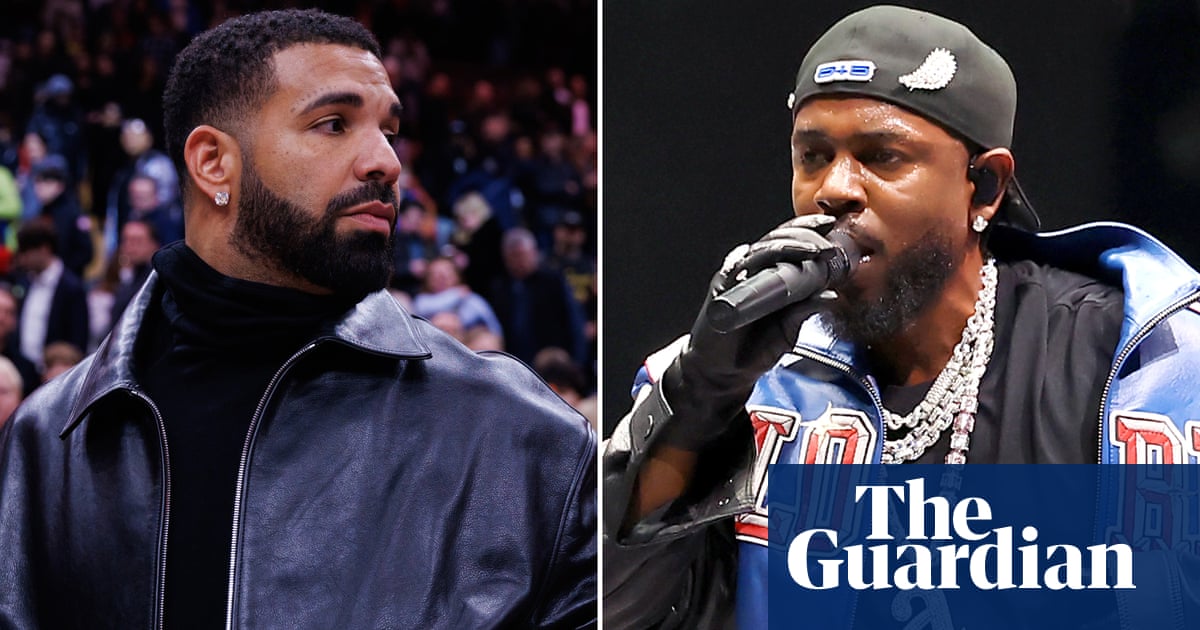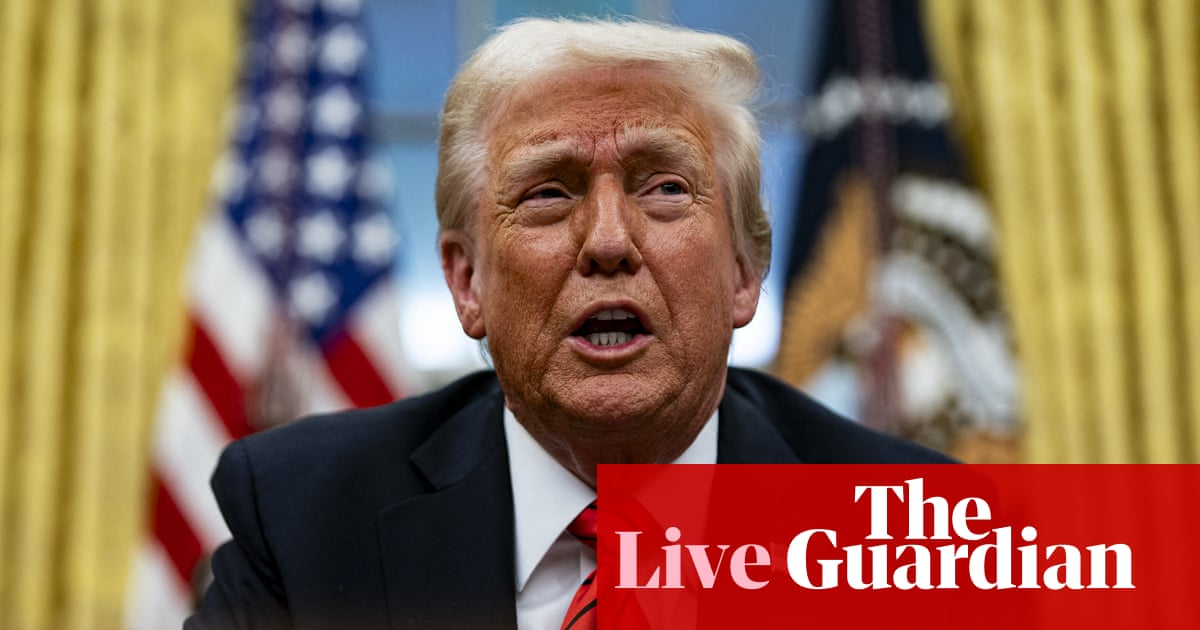It’s fitting that the Drake-Kendrick Lamar beef should end up on the Super Bowl field: “My intent from day one was to keep the nature of it as a sport,” Lamar said in an interview prior to his half-time show on Sunday. As the two rappers’ enmity built into a series of back-and-forth diss tracks in spring 2024, writers reached for boxing metaphors, describing “sparring”, “trading blows” or delivering “haymakers”. It was reminiscent of Pusha T’s words to the Guardian after his own spat with Drake: “What has been more energetic than this?” And of Drake’s own words on one of his earliest hits: “Sports and music are so synonymous / Cause we want to be them, and they want to be us.”
Drake fans might grumble that Lamar is now being less than sporting: having clearly won the beef thanks to the huge US No 1 success of Not Like Us – which framed Drake as a paedophile, a claim Drake outright rejected – he is now gleeful in victory. Last month he went to collect five Grammy awards for Not Like Us dressed in a “Canadian tuxedo”: Drake is from Toronto. At the Super Bowl, he brought out Serena Williams to dance during Not Like Us: Drake and Williams were once rumoured to be dating, and Drake later wrote hurt lyrics about her. Lamar’s special guest SZA was one of Drake’s own beloved creative foils. Lamar himself grinned down the camera as he rapped: “Say Drake, I hear you like ‘em young”. At both events, thousands-strong crowds chanted “tryna strike a chord and it’s probably A minor”, a line about paedophilia, at full volume – it was, Billboard stated, “even more deafening in the Superdome than the telecast suggested”. Kendrick wore a lower-case “a” pendant to underline the reference. The “stop, he’s already dead” Simpsons quote is being much shared, and has never been so appropriate.
“Kendrick Lamar didn’t just perform at the Super Bowl – he set a cultural agenda,” says Lauren Beeching, a UK-based expert in crisis PR for celebrities. “He’s put so many intelligent Easter eggs throughout the performance; the level of thought and detail in his performance means that this is going to be talked about for days, not hours.” Worse still for Drake, it was at the most popular sporting event in the US calendar. “Regular people are going to learn about it,” Beeching says. “They’ll be Googling: why is this news? If you open TikTok it’s everywhere. So this is being introduced to so many new people.”
The beef has clearly energised Lamar: his self-reflexive 2022 album Mr Morale & the Big Steppers was a touch underrated, but there’s no doubt the more playful, oxygenated flow he’s now using is thrilling. Audiences meanwhile love this gossipy, reference-rich sport. But what of Drake? He was once the world’s most-streamed artist, who seemingly had an easy command of every style he turned his hand to: trap, R&B, pop, dancehall, house and more. Now, he’s humiliated and flailing for credibility.
A failing was perhaps in trying to appeal to all of those audiences at once. There may well have been genuine passion in forming his collaborations with UK artists such as Section Boyz and Headie One, but – worsened with how he would sometimes mould his accent to south London, Jamaica and more – he became seen as a tourist who was extracting more cultural capital than he was giving back. It meant that when Lamar wrote another devastating section of Not Like Us, where he frames Drake as a leech absorbing cred from Atlanta artists like Future and Lil Baby, many listeners nodded along.
More prosaically, Drake has had backlash from suing his own label, UMG, over the allegations made in Not Like Us. “As a rapper it’s not the right look – it’s kind of disrespecting your own trade, and looks hypocritical,” Beeching says.
She says that “silence is key for someone like that right now,” and that when one of her clients gets drawn into a spat, “the first day is generally me begging them to not do anything publicly. His smartest move is to just wait, and come back with something that reframes the conversation entirely; a defensive response would be a mistake for him. If Drake tries to reclaim credibility in rap it could feel forced, what with him trying to sue. But maybe he could lean into another aspect of his brand” – one of those other styles, such as pop or R&B. “Luckily he’s commercially successful enough to be able to do that quite easily.”
Yet Drake seems unwilling to do that. After the diss tracks ended, he wrote on an image of a samurai facing an army: “Good times. Summer vibes up next.” Had he followed through on that promise, and gifted summer 2024 a more carefree pop-leaning track in the style of One Dance, Hotline Bling or Rich Baby Daddy, he would have reminded the world that here was a style which Lamar, for all his Pulitzer-winning acclaim, has never mastered. And then, perhaps, Drake could have worked his way back to rap credibility. Beeching gives an example of someone who handled a difficult moment well: Taylor Swift, after she was drawn into a feud with Kanye West and Kim Kardashian, and initially painted as a villain. “Instead of fighting back immediately, she disappeared: no statements, no interviews, no social media. Then she returned with Reputation, which acknowledged the backlash but on her terms, without engaging in messy public feuds. She didn’t take the bait, basically.”
But instead of pivoting to pop, Drake released three pure rap tracks – one of them with two Atlanta stars, Young Thug and 21 Savage, as if to reclaim his relevance in the city. Later, in January, came a freestyle in which he complained about the friends lost to the Lamar beef. After the Grammys, he went on stage in Australia wearing a vest with smoke pouring out of simulated bullet holes, to say: I’m still standing. Whether this is dignified or corny depends on how much of a Drake stan you are, but it’s undeniable how much the beef continues to affect him – and how his ego, which helped to make him such a big star, won’t let him move on.
Will the world let him, either? “Kendrick didn’t just challenge Drake musically, he’s damaged his character in a way that will linger,” Beeching concludes, and yet at the same time, the public tend to “forget really fast and easily – there’s so many public figures right now who were once cancelled or humiliated, who have come back after being quiet for a bit”.
Unlike so many of those figures, Drake has never been charged with a crime; he’s been gossiped about and has had some dubious moments, but has never seriously crossed a line in public, in the manner of Will Smith. His streaming numbers have dropped somewhat, but on Spotify there are still 74m people listening to him each month. And while Lamar will carry on performing Not Like Us on his stadium tour with SZA this spring – and everyone will sing along again with the “A minor” line – his victory lap for the beef will now come to a close, and he will probably move on from it.
Drake is now 38. That’s old in pop terms – like so many before him, he will almost certainly not remain relevant to each successive generation – but it’s young for an artist, and he remains versatile. He would be unwise to revisit it yet, but the encounter with Lamar, and the way Drake comes to live with it, could still interestingly shape his artistry. And as any sports fan will tell you, everyone loves an underdog – and a second-half comeback.
Article by:Source: Ben Beaumont-Thomas











:max_bytes(150000):strip_icc():focal(718x391:720x393)/louise-lasalle-tout-2825-c7e93a6a127e4a949029f49418004115.jpg?w=300&resize=300,180)
:max_bytes(150000):strip_icc():focal(718x391:720x393)/louise-lasalle-tout-2825-c7e93a6a127e4a949029f49418004115.jpg?w=80&resize=80,80)

